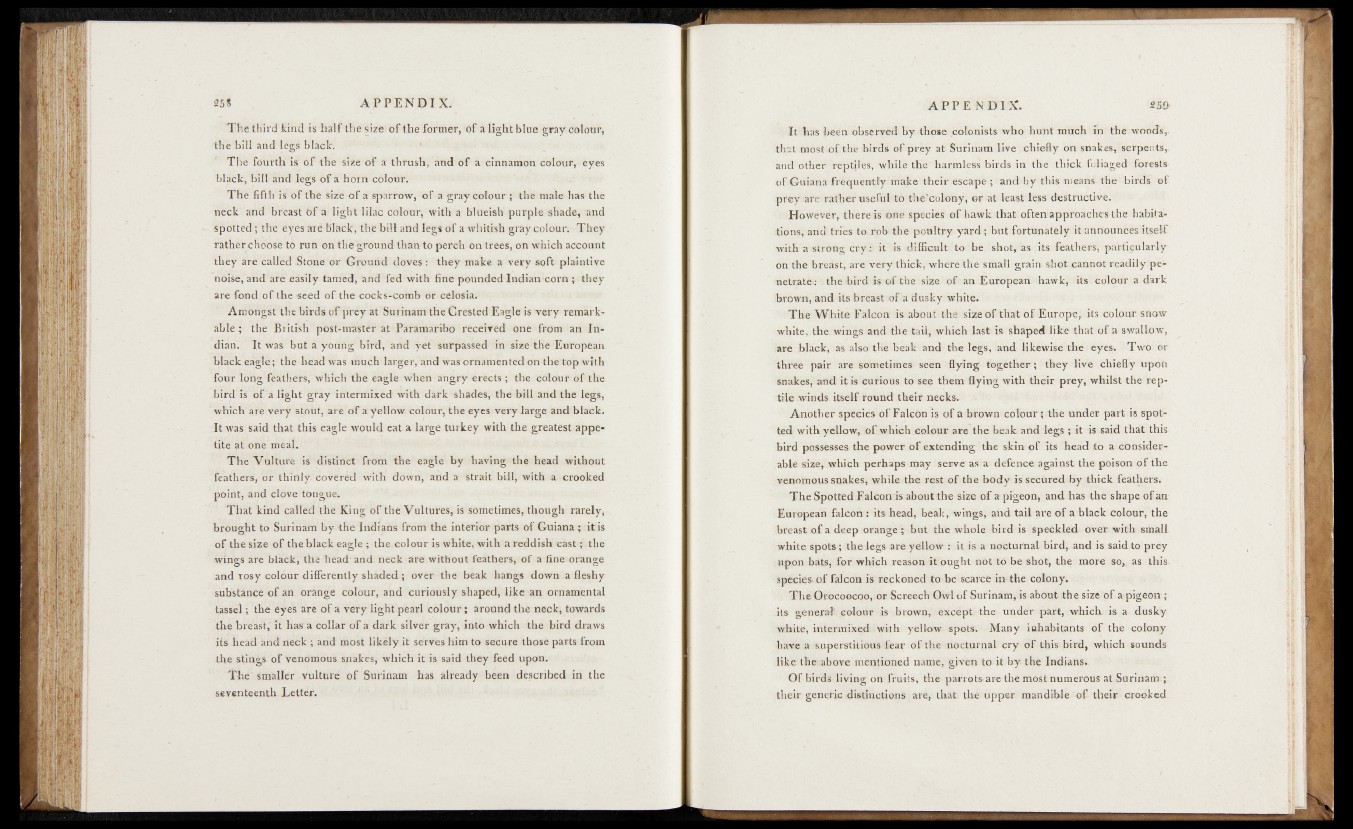
The third kirïd is half the size' of the former, a light blue gray dolónt,
the bill and' legs black.
The fourth Ï? o f the site of a fhtush, and o f a cinnamon colour, eyes
hlack, bill knd legs of a hofn colour.
Thé fifth tS of the size of a sparrow, o fa g r a y colour ; the male has the
neck and breast Of a light Iliad dölour, with a blueish purple shade, anid
Spotted] the dyes are' black, the bill and legs of a whitish gray colour. They
rather,dh'Oose tó run on the ground than to perch On trees, on which account
they arecalled Stooeor Ground doves: they make a very soft plaintive
noise, and'afe easily tamed, and fed with fine pounded Indian corn ; they
are fond o f the seed o f the cocks-comb or celosia.
Amongst the birds of prey at Surinam the Crested Eagle is very remarkable.;
« the British post-master'at Paramaribo received one from ah Indian.
It was but a youfig bird, and yet surpassed in size the European
Hack eagle; the head was ilitidh larger, and was ornamented on the top with
four long fearers, which the eagle when an^y drdctS ; the eHouifebfs the
bird is o f a light gray intermixed with dark shades, the bill and the legs,
which are very stout, are of a yellow colour, the eyes very large and black.
It was said that this eagle would eat a large turkey with the greatest appetite
at one meal.
The Vulture is distinct from the eagle by having the head without
feathers, or thiölycoVëréd with, down, and a strait bill, with a crooked
point, and clove tongue.
That kind called the King of the Vultures, is sometimes, though: rarely,
brought to Surinam by the Indians from the interior parts of Guiana ; it is
o f the size of the black eagle; the colour is white, with a reddish cast ;i. the
wings are black, the head and neck are without feathers, o f A finemrange
and rosy, colour differently shaded ; over the beak hangs down a fleshy
substance of an orange colour, and curiously shaped, like an ornamental
tassel; the eyes are of a very light pèarl colour; around the neck, towards
the breast,* it has a collar of a dark silver gray, into which the bird draws
its head and'üëok; and most likely it serves him to secure those parts from
the stings o f Venomous Snakes, which it is said they feed upon.
The smaller vulture o f Surinam has already been described in the
seventeenth Letter.
It fes been observed by those colbnists who bunt much in the woods,.
Chat most o f the birds of prey at Surinam live chiefly on snakes, serpents,
and other reptiles, while the'harmless birds in the thick foliaged forests
of Guiana frequently make therr escape ; and by this .means the birds of
prey >are rather useful to -tbe?CDlony, or at least less destructive.
However^Ihiërefs sène Sj^cies of hawk that ©ftenapproaeh&s the habitation
«] arid tries to. rob the poultry yard ; but fortunately it announces itself
with atstrong cry à it & difficult to be ’ shot] las : its feathers, particularly
on the breast, are very thick, where'the small grain shot cannot readily penetrate:
$ the bird is of the size o f a n European hawk, its colour a dark
brown, and Its breast of a dusky white.
The White IMcom about the size o f that of Europe,, its colour snow
white, the wingsand ihe -tail, which last is shaped like that of a swallow,
are black, as also the beak and the legs, and likewise the eyes. Two or
three pair are sometimes seen flying together ; they live chiefly upon
snakes, and it is curious to see them flying with their prey, whilst the reptile
winds itself round their necks.
Another species of Falcon is of a brown colour ; the under part is spotted
wi th yellow, of which colour are the beak and legs ; -.it is said that this
bird possesses the power jof extending the skin of its head to a considerable
Size, .which perhaps may server as a defence, against the poison o f the
venomous snakes, while the rest of the body is secured by thick feathers.
The SpottedFalconis about the size of apigeon, and has the shape ofan
European falcon : its head, beak, wings, and tail are of a black colour, the
breast of a deep orange ; but the whole bird is speckled, oyer with small
white spots ; the legs are ydlow : it is a nocturnal bird, and is said to prey
upon bats, for whieh reason it bugbt nOt'to be shot, the more so*, as this,
species, of falcon is reckoned to b e scarce in the colony.
The Ocoeoecoo, or Screech Owl of Surinam, is about the size of a pigeon ;
its general colour is brown, except the under part, which is a dusky
white, intermixed with yellow spots. Many inhabitants bf the colony
have a superstitious fear of the nocturnal cry of this ibird, which sounds
like the- above mentioned name, given to it by- the Indians. '
Of birds living on fruits, the parrots-aretbe mostnumerous at Surinam ;
their generic distinctions are, that, the uppur mandible of their Crooked